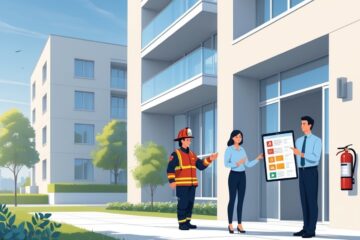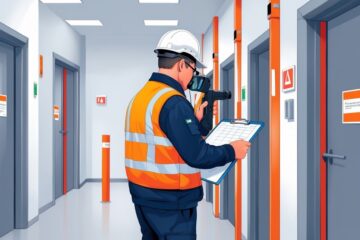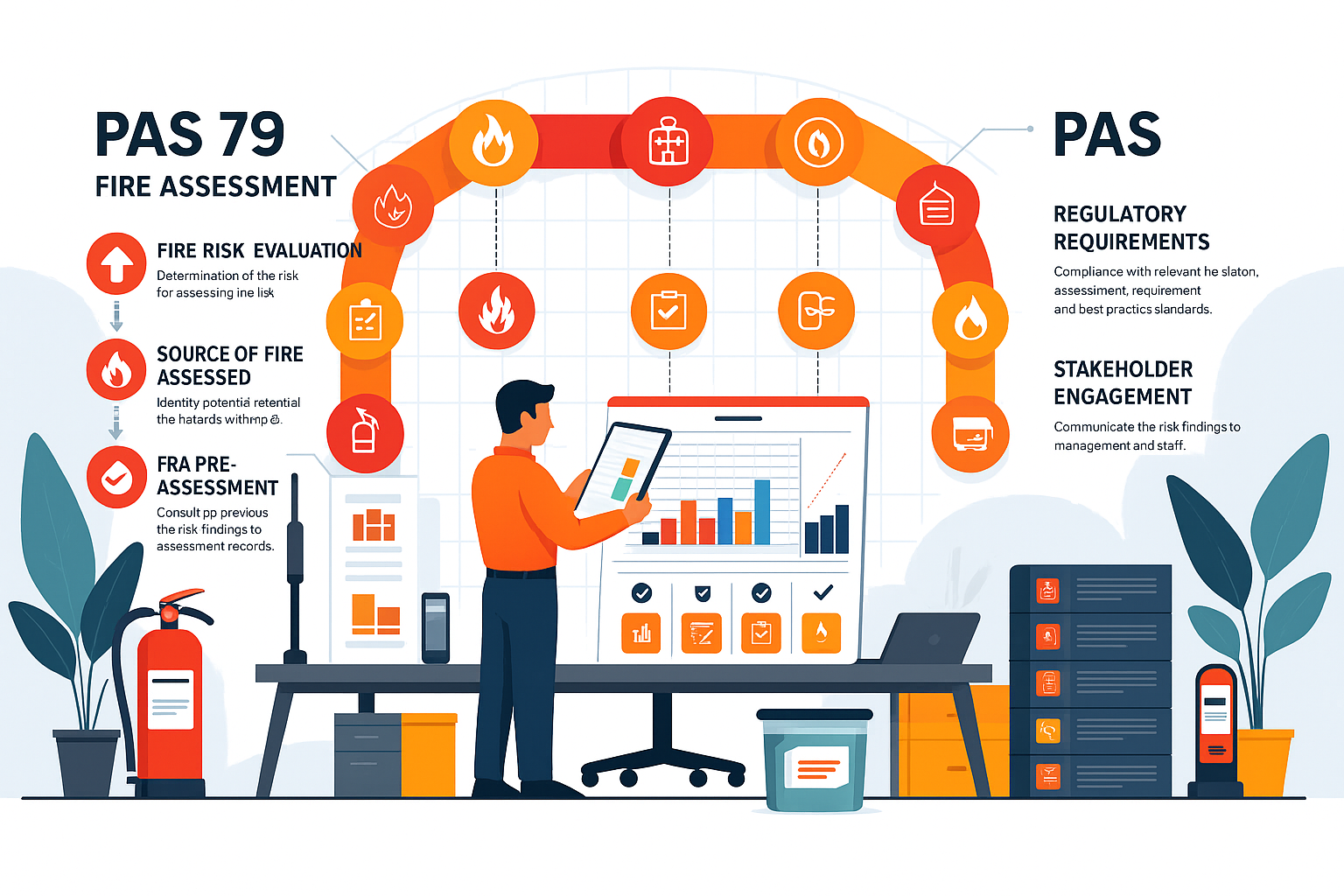The Fire Risk Assessment Regulatory Reform (Fire Safety) Order 2005 sets out clear rules for anyone responsible for a building to keep people safe from fire. You need to ensure your building complies with the law by identifying potential fire risks and taking steps to mitigate them. This law covers most buildings, such as offices, shops, and public places.
Fire Risk Assessment Regulatory Reform
Key Takeaways
- The law requires you to assess and reduce fire risks in your building.
- Regular safety checks and updates are essential for compliance.
- Proper training and clear information help everyone stay safe.
If you are an employer, a manager, or a building owner, you must know what is expected of you. Understanding the steps for carrying out a fire risk assessment and knowing your duties can help protect lives, property, and your business.
Overview of the Regulatory Reform (Fire Safety) Order 2005

The Regulatory Reform (Fire Safety) Order 2005 sets out important rules for fire safety in non-domestic buildings. You need to know what the law covers, its main goals, and basic terms used.
Key Principles and Aims
The Order’s main aim is to make sure people are safe from fire in workplaces and public spaces. It puts the responsibility for fire safety on people who have control of premises, called the “responsible person”.
You need to carry out a fire risk assessment, look for possible dangers, and take steps to lower the risk of fire or injury. Regular checks and clear planning are stressed. This means you must keep escape routes clear, have alarms and firefighting equipment, and train staff about what to do in an emergency.
Not following the law can lead to fines or closing your business. The Order also aims to make fire rules clearer and simpler by replacing older, separate fire laws with one set of standards.
Scope of the Legislation
The Fire Safety Order applies to almost all buildings, structures, and open spaces other than people’s private homes. This includes workplaces, community halls, shops, schools, care homes, and blocks of flats’ shared areas.
If you own or manage a business or building where the public comes in, this law likely applies to you. Even small businesses must follow the rules. The law covers both new and old buildings, with some minor exceptions—for example, private homes and some small, single-use outbuildings.
Key types of places included are:
- Offices and shops
- Factories and warehouses
- Schools and nurseries
- Hotels and guest houses
- Communal areas in flats
Key Definitions
Responsible person: This is usually the owner, employer, or anyone who controls the building or part of it. For shared spaces, more than one person may share this role.
Relevant persons: This means anyone who might be in the building, whether as staff, visitors, or contractors. Their safety must be part of the fire risk plan.
Fire risk assessment: This is a careful check to find out what in your building could cause a fire and who could be at risk. You must keep a record if you have five or more employees.
General fire precautions: These are steps you take to prevent fire and protect people if one does happen. They include things like fire exits, alarms, and safe storage of flammable materials.
Legal Duties and Responsibilities

You must follow legal requirements set out in the Regulatory Reform (Fire Safety) Order 2005. Key roles include who is responsible, what you have to do by law, and what can happen if you do not comply.
Responsible Persons
Under the Order, a “responsible person” is usually the employer, building owner, or occupier in control of the premises. If you own, run, or manage a building that is not a single private home, you are likely responsible for fire safety.
You must make sure your building meets fire safety standards. This includes shared areas in blocks of flats. More than one person can be “responsible” for the same building if areas are shared.
Examples of Responsible Persons:
| Premises Type | Responsible Person |
|---|---|
| Offices | Employer |
| Schools | Headteacher or Governing Body |
| Flats (shared areas) | Managing Agent or Freeholder |
| Shops | Owner or occupier |
If you are a contractor or someone in control of part of the building, you may share this duty.
Obligations for Employers and Landlords
As an employer or landlord, you must carry out a fire risk assessment. This should identify any fire hazards and risks to people on your premises. If you have five or more employees, this assessment must be written down.
You need to take steps to fix problems found in your assessment, such as making escape routes clear, keeping fire doors working, and providing suitable fire-fighting equipment. Staff must receive proper fire safety training.
Other duties include keeping escape routes clear, carrying out regular fire drills, and keeping fire safety equipment in good working order. Records of checks, training, and maintenance should be kept up to date.
Penalties for Non-Compliance
If you do not follow the Fire Safety Order, you may face warnings, fines, or even prison. Inspectors from the fire and rescue service can visit your building, check records, and issue notices if they find failures.
Possible penalties include:
- Formal notices requiring action
- Fines up to unlimited amounts for serious breaches
- Up to two years in prison for the most serious offences
You may also be closed down temporarily if there is a serious risk to safety. Insurance may become invalid if you ignore fire safety laws, leading to higher costs after an incident.
Core Elements of a Fire Risk Assessment
A fire risk assessment includes careful checks to spot possible fire dangers, see who might be at risk, and take clear action to prevent harm. This process helps ensure your building is safe and legal under the Regulatory Reform (Fire Safety) Order 2005.
Identification of Fire Hazards
You need to look for anything that could start a fire. The three main hazards are sources of ignition, fuel, and oxygen. Ignition sources include items like heaters, electrical equipment, or naked flames.
Walk around every area and pay close attention to where flammable materials are used or stored. Check for:
- Loose or faulty wiring
- Overloaded sockets
- Portable heaters left near paper or rubbish
- Litter or waste bins near heat sources
Prompt action to spot these hazards means you can control or remove them before they become a real danger. Make a list to keep track of everything you find.
Evaluating Risks to People
Next, work out who might get hurt if a fire starts. Think about staff, customers, contractors, and anyone who visits your building. Include people who may need more help, like children, older adults, or those with limited mobility.
Focus on where people are likely to be in the building, especially if they might sleep there or find it hard to escape. Make a table with these groups to help you plan:
| Group | Risk Factors |
|---|---|
| Employees | May be spread through building |
| Visitors | May not know escape routes |
| Disabled/elderly users | May need extra help to evacuate |
Look at escape routes, signage, and alarms to make sure everyone can get out safely.
Removing or Reducing Risks
Once you know the dangers and who is at risk, you must fix or lessen the hazards and make people safer. Remove items that may catch fire quickly, such as rubbish, unused furniture, or unnecessary flammable liquids.
Regularly service all electrical items and make sure you store dangerous materials in safe, closed spaces. Use fire doors and mark clear escape routes. Place fire extinguishers and alarms where they are easy to reach.
Simple actions like training staff and keeping exits clear will lower risk a lot. Check your plan often and update it when things in your building change.
Recording, Reviewing and Updating Assessments
You must keep clear records of your fire risk assessments, review them regularly, and update them to keep your workplace safe and compliant. Accurate documentation and scheduled checks are needed for legal and practical reasons.
Documentation Requirements
You are legally required to keep a written record of your fire risk assessment if you employ five or more people. This helps prove you are meeting your duties under the Regulatory Reform (Fire Safety) Order 2005.
Your record must include:
- The main findings of your fire risk assessment
- Any group of people at risk, such as disabled persons
- The actions you have taken or will take to reduce risk
- Names of people responsible for different fire safety tasks
Keep all documents in an organised file, either on paper or digitally. Make sure all staff can access the information if needed. Accurate and up-to-date records can help during official inspections or audits.
Review Frequency
You must review your fire risk assessment regularly to ensure it stays relevant. Key times to review include:
- After significant changes to your building, such as renovations
- When the nature of work or staffing changes
- If there is a fire or near miss
- At set intervals, for example, every 12 months
Regular reviews help you catch new hazards and address them before they become bigger problems. If your last review is more than a year old, arrange an updated assessment immediately. Set clear dates for reviews and stick to them.
Continuous Improvement
Fire safety is an ongoing process. As you spot new risks or incidents, you should use that information to improve your fire safety measures.
Encourage staff to report hazards or unsafe behaviours. Hold meetings to discuss fire safety and collect feedback. Use a checklist to track necessary adjustments:
| Task | Completed | Notes |
|---|---|---|
| Updated Procedures | ||
| Staff Training | Dates completed | |
| Equipment Checks | Repairs/replacement |
Regularly review this checklist and make improvements whenever possible. This approach keeps your workplace safer and helps prevent future incidents.
Implementation of Fire Safety Measures
You must put the right fire safety measures in place to protect people in your building. This includes both systems to spot fires early and clear ways to get out safely.
Fire Detection and Early Warning Systems
You should install fire alarms and smoke detectors across all areas. These systems warn people as soon as a fire starts. Early warnings save lives and give more time to respond.
Regular testing is vital. Check alarms every week and schedule full tests at least once a year. If devices are faulty, fix or replace them straight away.
Some buildings need extra technology. A table below summarises some types of detection:
| Type | Best for |
|---|---|
| Smoke Alarms | Most indoor spaces |
| Heat Detectors | Kitchens, boiler rooms |
| Manual Call Points | Near exits and corridors |
Clear signs should show where manual fire alarms are located. Make sure everyone knows what the alarm sounds like and what to do when it goes off.
Escape Routes and Emergency Exits
You must keep escape routes clear of obstructions at all times. Every door or corridor used for escape should be well lit and signed.
Emergency exits must be easy to open without keys or codes. Mark exits with clear signs that glow in the dark, so people always know where to go.
Keep a map or diagram of escape routes near main entrances. Give regular training to staff so they understand the routes.
List of key points:
- Check exits daily for blockages
- Post simple, readable instructions
- Provide ramps or wide doors for wheelchair users
Never lock or block exits. If routes are not accessible to all, you need to make changes as soon as possible.
Training and Information for Occupants
You must make sure everyone in the building knows how to act safely in case of fire. Giving clear training and sharing information helps people respond quickly and reduces confusion.
Fire Safety Training Programmes
Proper training helps you and others recognise hazards and understand what to do if a fire starts. Fire safety training often covers:
- Identifying fire risks
- Using fire extinguishers (if safe to do so)
- Alarm systems
- Evacuation plans
Many workplaces offer regular sessions for all staff, not just new starters. These sessions should follow up on the latest risks or changes to the building.
Records of training must be kept. This shows that everyone has received the right guidance. Make sure that training is simple, clear, and repeated when necessary so all staff remember what to do.
Communicating Emergency Procedures
You must explain emergency escape routes and procedures to everyone who might be on the premises. Display evacuation maps and emergency contact numbers where they are easy to see, such as on noticeboards or near exits.
Give instructions both verbally and in writing, avoiding technical language. Use simple terms or visual aids for those who do not speak English well or who have disabilities.
You should practise fire drills at least once a year and make adjustments if any issues appear. Keep everyone updated about changes to procedures as soon as they happen.
Role of Fire Authorities and Enforcement
Fire authorities are responsible for checking that businesses follow the Fire Safety Order. They also have legal powers to help prevent fires and protect lives.
Inspection Procedures
Fire authorities carry out inspections in workplaces, public spaces, and businesses. These checks are both planned and unannounced. The main goal is to make sure fire safety measures are in place and up to standard.
Inspectors look at the fire risk assessment, fire exits, alarms, and emergency plans. If problems are found, they give clear advice on what needs to change. A typical visit often includes interviews with staff, a tour of the building, and a review of fire safety documents.
What you can expect during an inspection:
- Physical check of fire doors, alarms, and escape routes
- Review of your fire risk assessment paperwork
- Questions about training and fire drills
Fire authorities will also look for signs that you take fire safety seriously. They pay attention to how clean escape paths are and if your team follows safe practices.
Enforcement Powers
Fire authorities have the power to enforce the law if they find faults. They can issue several types of notices:
| Notice Type | What It Means |
|---|---|
| Alterations Notice | Tells you to let the authority know before making certain changes |
| Enforcement Notice | Requires you to fix fire safety problems by a set deadline |
| Prohibition Notice | Stops the use of part/all of a building that is unsafe |
If you ignore these notices, authorities can take further action. This may include court action and fines. In serious cases, people may face prosecution or even prison if lives are at risk.
You have the right to appeal notices, but you should act quickly and follow the instructions given. Fire authorities aim to support and guide you, but safety must come first.
Common Challenges and Best Practice
Many find it difficult to keep fire risk assessments up to date and thorough. Clear procedures and regular training are important for meeting the law and reducing fire risk.
Typical Compliance Pitfalls
One common mistake is not reviewing fire risk assessments regularly. If you do not update them after changes in the workplace, you miss new risks.
It is also easy to overlook hidden hazards, like blocked fire exits or faulty alarms. Some focus only on obvious dangers and ignore storage areas or small offices.
Some places lack accurate records or have unclear instructions for staff. Without clear training, people may not know how to act during a fire.
| Pitfall | Example |
|---|---|
| Outdated assessment | No review after moving equipment |
| Blocked escape route | Storing boxes in hallways |
| Poor staff training | No regular fire drills |
| Incomplete records | Missing maintenance logs for alarms |
Strategies for Effective Compliance
Schedule frequent reviews of your fire risk assessment, such as every 12 months or whenever changes occur.
Use a checklist to inspect all parts of your property, including less-used spaces. Record findings and actions taken. Keep digital and paper copies in an easy-to-access location.
Hold regular fire drills and practice evacuation with all staff. Provide clear, simple training on emergency procedures and how to spot hazards.
Assign a responsible person to check fire safety equipment and update records. This keeps you organised and helps prove compliance during inspections. Use reminders and logs to track checks and actions taken.
I hope that helped!
If you want to read more, we wrote a very useful guide for Fire Risk Assessments that you should read.


